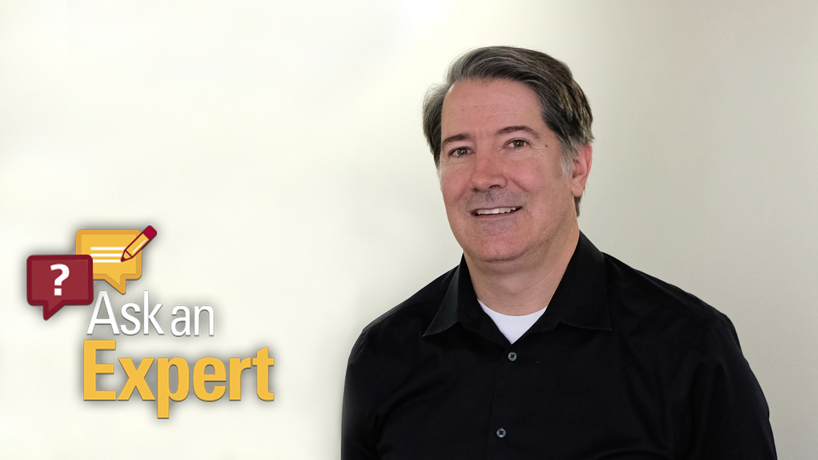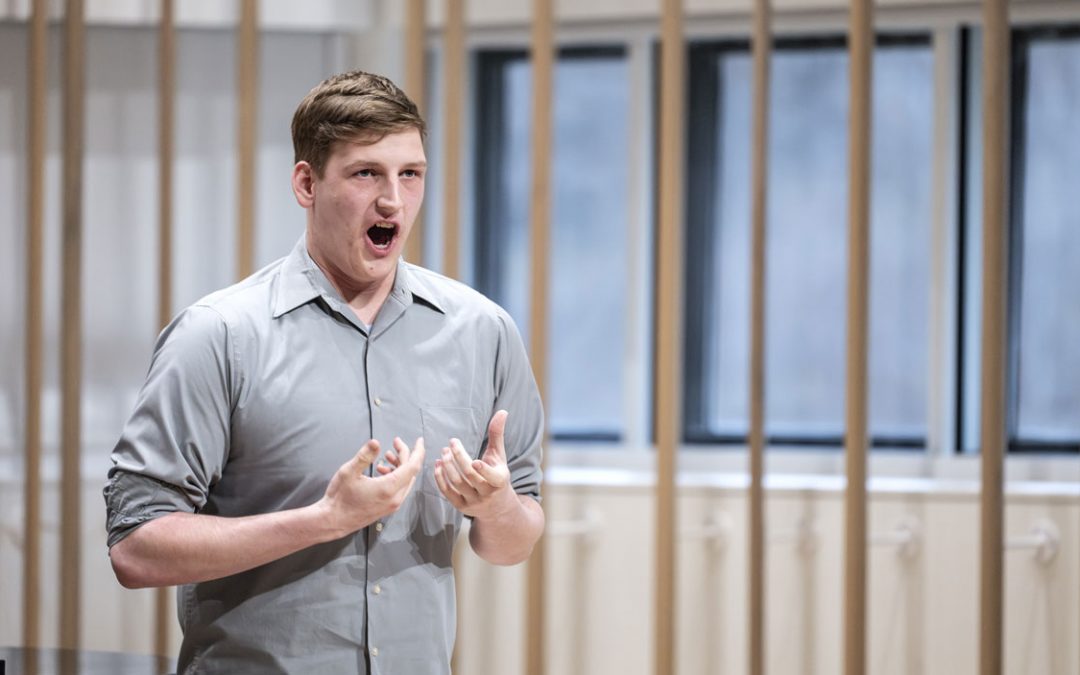
Political Science Professor David Kimball studies American government with much of his research focusing on election administration, voting rights and voting behavior. (Photo by August Jennewein)
Missourians will have their chance to weigh in on the Presidential primary process in the Democratic, Republican, Libertarian, Green and Constitution parties on Tuesday, but the attention paid to politics will not dissipate once it’s over.
Election coverage will likely dominate the national headlines all the way to November with much of it centering on the candidates chosen to serve as standard bearers for their respective parties.
But the electoral process – how people register to vote, how they cast their ballots and how the results are collected and protected – might also make news over the next eight months.
David Kimball, a professor of political science at the University of Missouri–St. Louis, researches election administration, voting rights and voter behavior. In the latest installment of its Ask an Expert series, UMSL Daily caught up with Kimball to discuss procedural and technological changes that have been impacting elections.
The crowded Democratic primary field that opened this election season seemed to inspire discussion of “ranked-choice” voting. That’s a topic you’ve conducted research in. Explain to readers how it works.
In the United States, it has been used almost entirely or currently is being used in local elections where there’s a one-seat contest. The way it works is voters rank their candidates in order of preference. They mark who their first choice is, who their second choice is, their third choice and so on. When the votes are counted, they count the first-choice votes first, and if there’s a candidate who has a majority of the first-choice votes, that person wins with the seat. The election’s over. But if there’s several candidates running and nobody has a majority on the first choice, then you start eliminating the candidates who had the fewest first-choice votes, and the votes for those candidates are transferred to whoever the voters’ second-choice was. The process of eliminating the last-place candidates, transferring their votes to the remaining candidates, recounting the votes – you keep doing that process until one candidate has a majority, and that person wins.
When did ranked-choice voting originate or at least start being implemented?
Worldwide, it goes back more than 100 years, and Australia, New Zealand and Ireland adopted some kind of version of this many, many years ago. The United States actually had a run with it back in between the 1910s and the 1940s, 1950s in some cities.
That was using the multi-seat version. There are different ways that can be done, but voters rank their candidates, and you eliminate the ones at the bottom and transfer their votes. It’s a little more complicated. But American cities got rid of that by the mid-20th century, and it only started making a comeback probably around 2000. Cambridge, Massachusetts, is the one city that’s kept it throughout.
Why do you think it’s an idea that appeals to people?
One reason that some cities have adopted ranked-choice voting is basically to give voters a chance to give a more complete expression of their candidate choices. The winner-take-all or plurality rules that we use for almost all of our elections is somewhat unsatisfying if there’s multiple candidates running, and you can only vote for one, and your first-choice maybe doesn’t have the best shot at winning. Do you still vote for that person or do you vote for a lesser candidate who you think has a better shot of winning? That’s sort of the fundamental question. You don’t want to waste your vote, and ranked-choice voting is a way for people to avoid that. They can indicate the first choice and their second choice, and if their first choice has no shot, their vote will transfer to their next choice. It’s designed to prevent a candidate from winning with 30 percent of the vote where maybe a majority didn’t want that person.
How that would work for the Democratic presidential nomination is a little less clear because what they’re really competing for in each state is delegates and those are already awarded proportionally, although you have to get above 15 percent to get any.
OK, so maybe it doesn’t apply to the primary race. Is it something you think will be used more often in other contests?
There’s definitely growing momentum behind it. The state of Maine right now is the only state that’s using it for some statewide offices. New York City just recently voted to adopt it starting next year, so that will be the biggest city by far to use it. There are probably 15 or 16 cities around the U.S. using it in their mayoral and city council elections. Cities and states have experienced elections where the winning candidate gets less than 50 percent of the vote, and maybe sometimes substantially less.
In the St. Louis city mayoral election in 2017 and in the election for president of the Board of Aldermen in 2019, the winner got 32 or 35 percent. I think those experiences have led people to think maybe there’s a better way.
In the management of elections, what sorts of technological changes have been taking place?
There have been several. Every state has a computer database of registered voters so that’s one thing that’s changed in the last 15 years or so. More and more places, particularly in Missouri, are using technology to check in voters at the polling place when they go vote, so it’s some kind of iPad device and you sign with your finger on the touch screen. That used to be a paper process. I think the one most noticeable to voters is voting machinery used to cast your vote. Every time you adopt new technology, there are chances that something might go wrong, even though there are benefits to these changes, too.
I think we saw that with the app that seemed to cause so many problems in last month’s Iowa Caucus.
The Iowa case was interesting in that they used a smartphone app to transmit the results from each of the precincts to the state party, and that broke down. But it sounds like other processes broke down, too, and they had trouble calling the results in by phone. One takeaway I have from the Iowa Caucus is not to try out a new app or technology for a big election without testing it first on a smaller scale to make sure there are no bugs. The second thing – and I think what made the Iowa experience worse – was that this was party officials running the election, not the Iowa state election officials or county auditors who know how to run an election, have tons of experience doing it and are used to running into glitches and having to go to Plan B to get the results in.
The Iowa Democratic Party doesn’t run elections. They do the Iowa Caucuses once every four years, and that’s about it. If we want reliable elections, we should have them be run by experienced people. If you let party people once in a while come and run them, you’re asking for trouble.
How have people been managing the tradeoffs between the efficiencies that theoretically should come from technology versus the reliability of it and susceptibility to security issues?
That’s a really important tradeoff and an important concern. In terms of the equipment that we vote on, there has been a movement back toward paper ballots, in part due to some concerns about the reliability of computer equipment and that it might be susceptible to hacking, even though the voting machines themselves – at least in the vast majority of cases I’m aware of – are not connected to the internet so an internet hack isn’t possible. If you still have those paper ballots leftover after the election, you can audit them or recount them and verify the results.
I think on the voter registration side, I don’t think there’s any turning back. You have computerized databases for that, and in a state like Missouri with 116 local jurisdictions that administer elections, each has their own database of registered voters that they need to share with the state, that system is going to be on the internet. That’s how they sync up their lists and share information. I think that’s the area that’s more vulnerable to this breakdown or hacking. That’s where state and federal officials are enlisting cybersecurity experts to try and make sure those systems are safe and protected.
What is being done to make it easier for people to register to vote?
There’s really three things. The smallest one is allowing people to register online, which Missouri now started doing recently. That’s a somewhat smaller scale convenience reform. The second is allowing people to register to vote up to and including on election day, which is again more of a convenience for people who forget or are unaware that in some states like Missouri the deadline to register is a month before the election. The third is some procedure of automatically registering people to vote once they turn 18, once they get a driver’s license or engage with some state agency that then has their address and information. A few states are doing that, including Oregon, California. Illinois is moving in that direction.
Will we ever get to a place where the rules are the same nationwide, both in the way we run elections and the way we register for them?
Probably not. It would take an act of Congress to do that, and a lot of states would come kicking and screaming – those that have to change. It’s difficult to get any legislation passed in Congress period right now because the two parties are so sharply divided, but it’s especially difficult to pass election legislation in Congress because one party or the other will decide this is going to be bad for our party, so we’re going to oppose it. You’d have to have one party in total control of Congress and the White House. That’s unlikely, so we’re stuck with lots of different election rules, varying from state to state and even from county to county.
What are the biggest problems with having so many different systems?
It’s confusing for voters, particularly voters who move from one state to another or from one county to another and assume, incorrectly, that the rules here are the same as they were where they were before. It can create problems when there’s a really, really close election and this state counted the votes this way, but that state counted the votes a different way. The loser might feel that’s unfair. Or this county handled absentee ballots a certain way and another county in the same state handled them a different way. In a really, really close election, that raises questions about the outcome.
It’s also hard to educate voters about the process when the rules of the process differ from state to state and from county to county. It’s hard to develop an effective voter education effort when you have to change the content when you cross county lines.
Election officials from other countries often come here to observe our elections, and they tend to think we’re crazy. In just about every other country in the world, there’s some independent election commission that runs the national elections. It’s an office and staff that’s somewhat removed from politics and partisan control. They adopt rules that are consistent nationwide. They look at us, and we have a different person running elections in each different county and that person is elected himself and often running for reelection while managing election. They look at us like we’re crazy, and sometimes I think they’re right.














